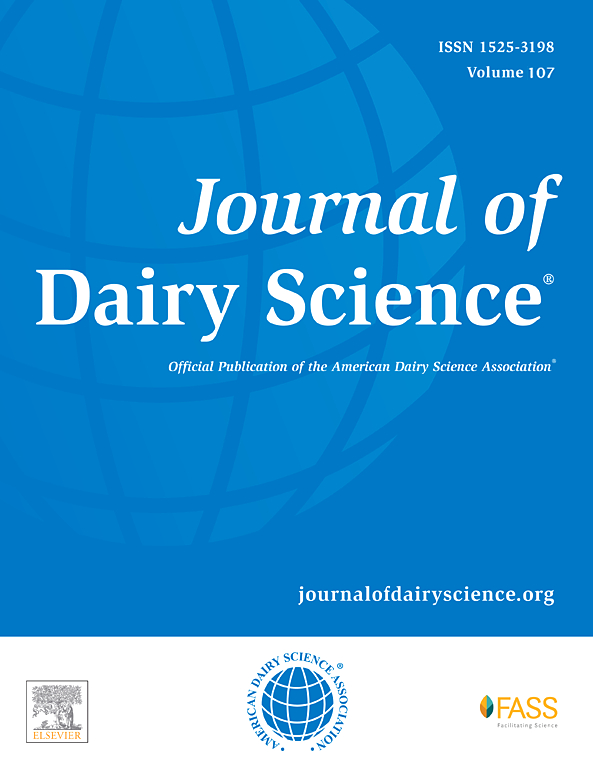Effects of milk extracellular vesicles from Holstein Friesian and Brown Swiss heat-stressed dairy cows on bovine mammary epithelial cells
IF 3.7
1区 农林科学
Q1 AGRICULTURE, DAIRY & ANIMAL SCIENCE
引用次数: 0
Abstract
The increase in ambient temperature is responsible for a behavioral, physiological, and metabolic responses known as heat stress, which affects dairy cows' general well-being, health, reproduction, and productivity. Focusing on the functioning of the mammary gland, attention has been recently paid to a new method of cell-cell communication mediated by extracellular vesicles, which with their cargo can affect the target cells' phenotypic traits, behavior, and biological functions. This study investigated whether the small extracellular vesicles (sEV) isolated from milk of heat-stressed Holstein Friesian (H) and Brown Swiss (B) cows affect the cellular response of a bovine mammary epithelial cell line (BME-UV1). To this purpose, 8 mid lactation cows, 4 of each breed fed the same diet and kept in the same barn, which experienced the same hyperthermia during a natural heat wave, were chosen to collect 2 milk different samples: under thermoneutrality (TN, d1) and under heat stress (HS, d 8) conditions. The sEV were isolated from skim milk samples through differential centrifugations, characterized for size and concentration by nanoparticle tracking analysis. Integrity of the milk sEV membranes was evaluated by transmission electron microscopy and presence of EV markers through western blotting. Then BME-UV1 cells were incubated for 24 h with different pooled milk sEVs (H-TN, H-HS, B-TN, B-HS). Cell viability and apoptosis assay, reactive oxygen species production, and mRNA expression of heat shock proteins and antioxidant genes by reverse transcription and real time PCR were determined. In vivo results showed an increase in rectal temperature and respiration rate, a reduction in milk yield both for H and B dairy cows, with a lowest decrease observed in B cows compared with H cows. In vitro results of BME-UV1 cells treated with milk sEV H-HS and B-HS showed an alteration of the cell viability and metabolic activity, by reducing or increasing reactive oxygen species accumulation, and suppressing or increasing the expression of stress-associated genes thereby modulating the response of BME-UV1 according to the animals' thermal condition and the breed. These findings indicated that the small vesicles of Brown milk triggered cellular defense against heat stress, supporting the Brown Swiss breed's thermotolerance.
热应激奶牛乳细胞外囊泡对奶牛乳腺上皮细胞的影响。
环境温度的升高会导致被称为热应激的行为、生理和代谢反应,它会影响奶牛的整体健康、繁殖和生产力。以乳腺的功能为中心,近年来人们关注了一种由细胞外囊泡介导的细胞间通讯的新方法,细胞外囊泡及其载物可以影响靶细胞的表型性状、行为和生物学功能。本研究研究了从热应激荷斯坦弗里西奶牛(H)和布朗瑞士奶牛(B)的牛奶中分离的小细胞外囊泡(sev)是否影响牛乳腺上皮细胞系(BME-UV1)的细胞反应。为此,选取8头泌乳中期奶牛,每个品种4头,饲喂相同日粮,饲养在同一牲口棚,在自然热浪中经历相同的高温,在热中性(TN第1天)和热应激(HS第8天)条件下采集2种不同的牛奶样品。通过差速离心从脱脂牛奶样品中分离出sev,并通过纳米颗粒跟踪分析对其大小和浓度进行了表征。通过透射电子显微镜和Western blotting检测EV标记物来评估牛奶sev膜的完整性。然后将BME-UV1细胞与不同的混合牛奶sev (h - tn、h - hs、B-TN、B-HS)孵育24 h。RT-qPCR检测细胞活力和凋亡、活性氧产生、热休克蛋白和抗氧化基因mRNA表达。体内实验结果显示,H型奶牛和B型奶牛的直肠温度和呼吸速率升高,产奶量下降,其中B型奶牛的下降幅度最小。牛奶sEVs H-HS和B-HS处理BME-UV1细胞的体外实验结果显示,根据动物的热环境和品种,通过减少或增加ROS积累,抑制或增加应激相关基因的表达,从而调节BME-UV1的反应,从而改变细胞活力和代谢活性。这些发现表明,棕色牛奶中的小泡触发了细胞对热应激的防御,支持了棕色瑞士品种的耐热性。
本文章由计算机程序翻译,如有差异,请以英文原文为准。
求助全文
约1分钟内获得全文
求助全文
来源期刊

Journal of Dairy Science
农林科学-奶制品与动物科学
CiteScore
7.90
自引率
17.10%
发文量
784
审稿时长
4.2 months
期刊介绍:
The official journal of the American Dairy Science Association®, Journal of Dairy Science® (JDS) is the leading peer-reviewed general dairy research journal in the world. JDS readers represent education, industry, and government agencies in more than 70 countries with interests in biochemistry, breeding, economics, engineering, environment, food science, genetics, microbiology, nutrition, pathology, physiology, processing, public health, quality assurance, and sanitation.
 求助内容:
求助内容: 应助结果提醒方式:
应助结果提醒方式:


